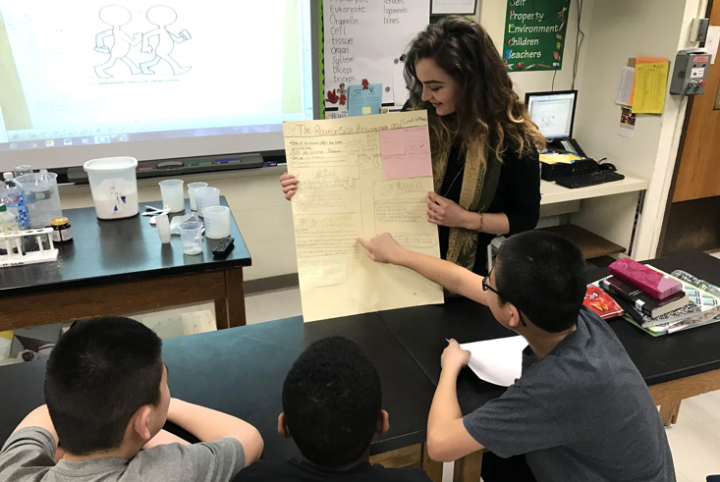Supporting Preservice Teachers with Task-Based Instruction

Why It Matters To You
- Preservice Teachers, specifically those beginning their early clinical experiences, need tools that can support both their planning and implementation of science instruction focused on student sensemaking.
- Task-based instruction can support Preservice Teachers to plan and implement 3D learning, while also offering them opportunities to begin gaining experiences implementing at a scale (e.g., 1-2 day lessons) that is more feasible for beginning teachers and more easily negotiated in the contexts of Mentoring Teachers’ classrooms.
What Is The Issue?
Experiences in mentor teachers’ classrooms often provide preservice teachers with their first opportunities to spend extended periods of time in classrooms as teachers or to engage with the new vision for science education. Taking on too much too early (e,g., planning a full unit of instruction) can be stressful for both preservice and mentor teachers, who need to ensure their students are supported with coherent learning experiences. Task-based instruction—planned and implemented collaboratively with university educators and mentor teachers in local P-12 classrooms—can address these challenges.
Authors:
DANIELLE ROSS, TODD CAMPBELL, TJ MCKENNA, VICTORIA SCHILLING, LAURA RODRIGUEZ & UCONN TEACHER MENTORING COLLABORATIVE | FEBRUARY 2018
Reflection Questions
- In an upcoming unit, how can you support a preservice teacher to develop a new task-based instructional activity or modify an existing activity?
- How might you support preservice teachers to plan for and facilitate discussions in task-based learning activities?
- What hesitations or concerns do you and the preservice teacher have about task-based activities? How can mentor teachers, preservice teachers and university educators collaborate to address these concerns?
Things to Consider
- Understanding phenomena entails “finding and describing patterns… looking for and testing relationships, and making connections between cause and effect” (Cartier et al., 2013, p. 85). Put succinctly, students have to engage in thinking to understand phenomenon.
- Task-based instruction involves the following types of tasks, among others: (1) Experimentation, (2) Explanation, and (3) Data Representation, Analysis, and Interpretation Tasks.
- Teachers can help support students by actively surfacing their thinking with focused talk, which engages students in dialogue that pushes their thinking toward ideas necessary to move their learning forward. Task-based instruction includes activities that support focused talk, including careful selection of goals and tasks, anticipating and monitoring student thinking, and selecting, sequencing, and connecting student ideas with important science ideas and experiences (Cartier et al., 2013).
- “What teachers choose to attend to during instruction…will ultimately determine whether or not students become active thinkers, constructors and evaluators of knowledge in science.” Teachers can scaffold this through three kinds of focused talk: “(1) mak[ing] students’ thinking visible; (2) guid[ing] students’ thinking in productive directions; (3) direct[ing] students’ attention toward features of the problem space that matters” (Cartier et al., 2013).
Attending to Equity
- Preservice teachers, early in their work in schools, commonly find it difficult to move the focus away from their own teaching practices and to student reasoning. This can impact their students’ experiences, as preservice teachers are not yet considering the different experiences (e.g., racial, linguistic, cultural, gendered) that their students bring to the classroom (Tate et al., 2008).
- The 5 instructional practices highlighted as central to task-based instruction support teachers to draw on students’ localized and community resources and ways of knowing as valuable tools to build understanding. In fact, the focus on sensemaking in these tasks and in the new vision for science education positions students to draw on the ‘immediate feedback’ (Resnick & Rosenbaum, 2013) offered as the ‘world speaks’ as an arbiter in measuring their moment-to- moment attempts to explain phenomenon or reason about experiments, data representations, analyses, or interpretations. This can lead to what DiGiacomo & Gutiérrez (2016) refer to as symmetrical relational equity among students and between teachers and students.
Recommended Actions You Can Take
- Read 5 Practices for Orchestrating Productive Task-Based Discussions in Science to learn more about task-based instruction. It also includes example tasks and case studies of teachers implementing it in classrooms.
- Explore the following templates created to support preservice teachers in designing and implementing task-based instruction: Selecting Goals and Selecting Tasks; Anticipating and Monitoring; Selecting, Sequencing, and Connecting; Lesson Planning Implementation Guide.
- Examine and consider implementing some example tasks developed by preservice teachers (e.g., Natural Selection; Frog Deformities).
ALSO SEE STEM TEACHING TOOLS
- #6 Productive Classroom Talk
- #37 Student Facets of Thinking
- #49 Preservice Teacher Supports
- #50 Orienting to Sensemaking
STEM Teaching Tools content copyright 2014-22 UW Institute for Science + Math Education. All rights reserved.
This site is primarily funded by the National Science Foundation (NSF) through Award #1920249 (previously through Awards #1238253 and #1854059). Opinions expressed are not those of any funding agency.
Work is licensed under a Creative Commons Attribution-ShareAlike 4.0 Unported License. Others may adapt with attribution. Funded by the National Science Foundation (NSF). Opinions expressed are not those of any funding agency.


 Email Feedback
Email Feedback


